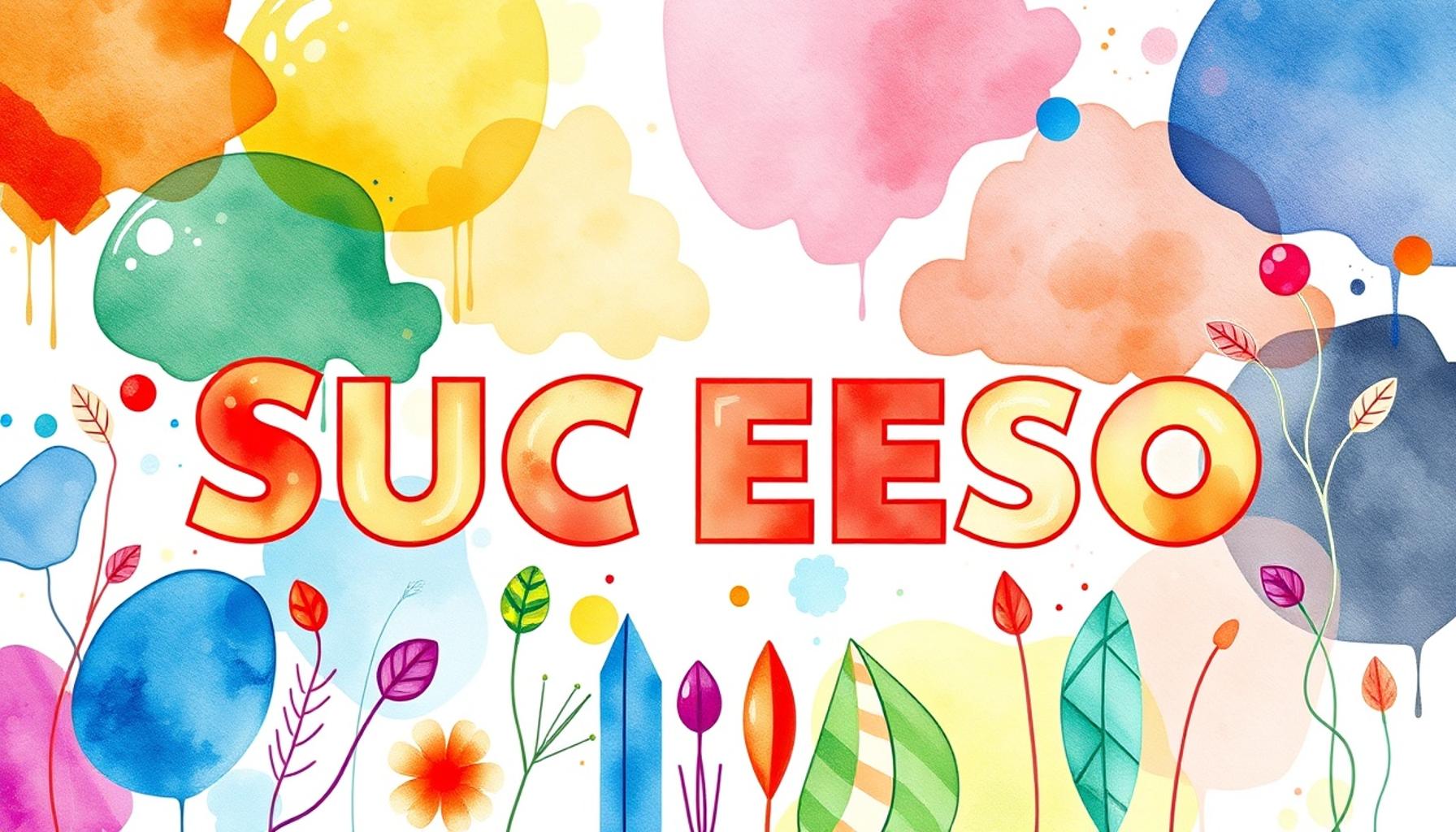Visualization of Success as a Tool for Setting Realistic Goals

The Power of Visualization: A Pathway to Success
Every great achievement begins with a vision. The practice of visualization is not only about dreaming big but also about mapping out a realistic pathway to success. By vividly imagining our goals and aspirations, we can create a mental image that serves as a guiding light through the sometimes murky waters of personal and professional development. This technique is about aligning our ambitions with as many tangible outcomes as possible, honing our focus and driving our actions forward.
Visualization can serve as a powerful catalyst for setting achievable objectives. The benefits of this transformative practice are profound and can reshape one’s journey toward success. Here are some key advantages:
- Clarity of Purpose: Visualizing success clarifies what you truly want. For instance, a young entrepreneur in Lagos may visualize their brand becoming a household name, which allows them to define specific, actionable steps to achieve that level of recognition.
- Motivation Boost: Imagining your success can enhance your determination to work hard. The mental imagery of crossing the finish line in a marathon, for example, can motivate a runner to push through the physical barriers they face during training.
- Preparedness: Practicing visualization can mentally prepare you for challenges. A student anticipating an important exam can visualize themselves calmly answering questions confidently, which can alleviate anxiety and optimize performance.
In Nigeria, where opportunities and challenges abound, leveraging visualization can be particularly impactful. Many successful entrepreneurs have employed visualization techniques to:
- Define their goals clearly, such as a fashion designer envisioning their works being showcased at international fashion weeks.
- Overcome obstacles by anticipating potential setbacks, enabling them to craft strategic plans better addressing hurdles like economic fluctuations or competition.
- Enhance their focus and commitment towards their targets, ensuring they remain steadfast even amidst external distractions.
With the right approach, anyone can harness the power of visualization to set realistic goals and navigate the complexities of achieving them. This practice goes beyond wishful thinking; it involves a deliberate process of mental rehearsal that activates a sense of purpose and commitment.
For those wishing to delve deeper into this transformative technique, consider incorporating daily visualization exercises. Spend a few moments each day picturing not just the end goal, but the steps taken to reach it. Imagine the sights, sounds, and emotions of that journey. By doing so, you can create a structured roadmap toward success that is intricately connected with your aspirations and practical realities.

As you explore the nuances of visualization, remember that champions of business and personal development throughout Nigeria have used this technique not just to dream but to achieve, transforming their visions into reality. The journey may be challenging, but with strong mental imagery and strategic planning, the destination is within reach.
CHECK OUT: Click here to explore more
Bridging Dreams with Reality through Visualization
Visualization serves as a bridge between dreams and reality, empowering individuals to carve out a realistic roadmap toward their aspirations. This compelling technique is not merely about wishful thinking; it requires practitioners to actively envision their goals and articulate the steps necessary to achieve them. By creating a detailed mental image of success, individuals can significantize the connection between their aspirations and achievements, thus enhancing motivation and focus.
At its core, visualization works on several psychological principles that can fundamentally shift how we approach goal setting. Research has shown that when we visualize a desired outcome, our brain activates neural pathways that prepare us physically and mentally for success. This means, when a person imagines closing a significant business deal in Nigeria, their mind engages in behaviors that promote goal achievement, such as networking effectively, conducting thorough research, and preparing persuasive presentations.
To leverage the true potential of visualization for setting realistic goals, consider these key components:
- Detailed Imagery: It’s vital to visualize not just the end result but the journey itself. For instance, a budding tech entrepreneur in Nigeria should go beyond picturing their startup gaining international acclaim and should immerse themselves in the daily tasks that lead to that success. This can include rehearsing pitches, planning product developments, or networking with industry experts.
- Emotional Connection: Engaging the emotions tied to achieving a goal can amplify the effectiveness of visualization. By feeling the excitement, gratitude, and pride associated with success, an individual can enhance their determination to follow through. Imagine a young musician envisioning their debut album topping the charts while feeling the joy that accompanies such recognition.
- Regular Practice: Consistent visualization practice can significantly heighten its impact. Allocating time every day to visualize your goals enables you to internalize your journey toward achievement. A student preparing for a competitive examination can benefit from regularly picturing themselves confidently solving problems, leading to heightened self-assurance during the actual assessment.
The role of visualization becomes even more critical within the dynamic landscape of Nigeria. With challenges like economic instability and competitive environments, individuals must be proactive in visualizing success as a strategy for navigating obstacles. For many African entrepreneurs, visualization is a tool that helps them not only in defining what success looks like but also in strategizing their actionable steps to overcome hurdles like funding issues or market saturation.
As you embark on your journey of incorporating visualization into your goal-setting practices, remember that it requires time and commitment. It is an ongoing process that builds upon itself, reinforcing the mental frameworks needed to thrive. Seek inspiration from the stories of fellow Nigerians who have adeptly used visualization techniques to forge their paths, creating resilient and successful businesses that uplift communities and inspire future generations. In this way, visualization becomes not just an individual tool but a collective asset for growth and empowerment across the nation.
| Advantages | Details |
|---|---|
| Enhanced Focus | Visualization acts as a magnet for your attention, making it easier to stay on track towards your goals. When you visualize success, your brain chemistry changes, triggering motivation and determination to achieve your objectives. |
| Improved Clarity | By regularly picturing your success, you gain clarity on what you really want. This clearer vision allows you to break down your goals into manageable steps, simplifying the path to success. |
| Increased Confidence | Envisioning your success boosts your self-confidence, making you more likely to take necessary risks and make bold decisions in pursuit of your goals. This self-belief is crucial for overcoming barriers. |
| Stress Reduction | Visualization can serve as a form of mental relaxation that reduces anxiety. By picturing a successful outcome, you prepare your mind to handle real-world stress better, thus enhancing performance. |
The theme of “Visualization of Success as a Tool for Setting Realistic Goals” shares invaluable insights into how the human mind can be harnessed to achieve personal and professional aspirations. The benefits of visualization transcend simple daydreaming; they involve profound psychological shifts that invigorate the journey to success. Each visualization session prepares the mind for opportunities and challenges, fostering a proactive approach that catalyzes achievement. Explore how these techniques can redefine your understanding of attainable goals and inspire a renewed drive for success.
ADDITIONAL INSIGHTS: Expand your understanding here
Harnessing the Power of Visualization in Everyday Life
Incorporating visualization into daily routines can transform aspirations into achievable goals, especially in a rapidly evolving environment like Nigeria. The notion that our thoughts can manifest into reality isn’t just inspirational—it is a practical approach supported by cognitive psychology. By imagining detailed scenarios of success, individuals can build a framework for the actionable steps that lead to their dreams.
One of the most compelling aspects of visualization is its versatility across various contexts. From students preparing for national exams like the Unified Tertiary Matriculation Examination (UTME) to professionals aiming for career advancements, visualization can serve as a powerful tool. For example, a university student in Nigeria may visualize themselves confidently answering questions in an exam hall while feeling the tension dissolve away. Engaging in this practice not only reduces anxiety but ensures that the individual is mentally rehearsing the material needed for success.
Another critical application of visualization lies in entrepreneurship, particularly within Nigeria’s vibrant small and medium enterprises (SMEs). Visualizing success can help business owners set realistic sales targets, market entry strategies, and customer engagement techniques. A local fashion designer can imagine their designs showcased at a renowned fashion event while mentally preparing for the necessary steps, such as creating a collection, seeking buyers, and effectively promoting their brand through social media and local markets.
Furthermore, organizations can also harness visualization techniques to enhance team cohesion and align collective goals. Workshops that encourage employees to visualize their company’s future can foster a sense of ownership and commitment. For instance, by encouraging staff members to envision their role in elevating the company’s reputation, they are more likely to work collaboratively toward that vision.
A crucial element of successful visualization is the incorporation of metrics to gauge progress. Establishing measurable goals alongside visualization enhances accountability. For instance, a graduate aspiring to gain employment can visualize acing interviews while concurrently setting specific targets, such as sending out fifteen applications per week or attending three networking events a month. This dual approach ensures that motivation remains high while fostering achievable expectations.
Social proof plays a significant role in the effectiveness of visualization as well. Success stories from fellow Nigerians, like the emergence of tech hubs in cities such as Lagos, showcase how visualization led to tangible transformations. Entrepreneurs like Iyinoluwa Aboyeji, co-founder of Andela, have openly discussed the power of envisioning a tech-driven Africa. Their journeys underscore how viewing success not only ignites personal ambition but also serves as a blueprint for others.
Integrating visualization into everyday life enables individuals to confront challenges with renewed vigor. By actively imagining both the struggle and the success, aspirants can develop resilience, reinforcing their belief that they can surmount adversity. Visualizing success is, therefore, not merely an act of dreaming; it’s a robust strategy for setting realistic goals that align with individual circumstances and aspirations.
As individuals across Nigeria adopt this powerful tool, it is essential to acknowledge that visualization is best coupled with action. It is a journey of hope, resilience, and practical steps forward, inspiring a generation to concretize their visions into reality.
SEE ALSO: Click here to read another article
Concluding Thoughts on Visualization of Success
In conclusion, the visualization of success emerges as an invaluable tool in the journey of setting realistic goals, particularly in a dynamic and evolving landscape like Nigeria. By harnessing the power of mental imagery, individuals can not only articulate their desires but also devise structured, actionable plans to achieve them. Whether it’s students preparing for examinations or entrepreneurs dreaming of expanding their businesses, the ability to visualize success creates a mental roadmap that enhances focus and motivation.
This practice fosters not only an increased sense of confidence but also promotes resilience in the face of challenges. As illustrated through various examples of Nigerian success stories, visualization serves as a catalyst for transformation and innovation, paving the way for others to follow suit. The synergy of visualization and measurable action helps in tracking progress effectively, ensuring that aspirations are kept within reach.
Moreover, as communities embrace the benefits of visualization, there is potential for significant socio-economic advancements. Imagine a future where more individuals are claiming their successes, inspired by the tangible outcomes of their visions. As we advocate for this approach, let us remember that visualization must be paired with consistent action, resilience, and accountability to fully realize its potential.
Therefore, it is essential for individuals across Nigeria—and globally—to not only dream vividly but to combine that vision with practical steps forward, creating a roadmap to success that inspires and uplifts not just themselves, but their communities as well.



